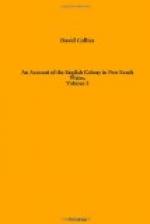The Norfolk passes the strait
Observations thereon
Proceeds to the southward
Passes the S. W. Cape; and S. Cape
Remarks on the latter
De Witt’s Isles
Storm Bay Passage
Tasman’s Head
Fluted Cape
Frederick Henry Bay
Enter the Derwent river, first seen in the ship Duke,
of Bengal
Observations on the Derwent
Some natives seen
Particulars of one
Venomous snake
One destroys itself
Comparison between New South Wales and Van Dieman’s
Land
Arrive at Port Jackson
Advantages of the strait
Mr. Bass and his fellow voyager, Lieutenant Flinders, did not hesitate now to think that they had passed through the strait, and from the Pacific had entered the southern Indian ocean; for what within the extent of a vast sea could give birth to the monstrous swell that was rolling in before their eyes? and the coast was evidently trending towards the SW cape.
Mr. Bass says (with all the feeling and spirit of an explorer), that ’he already began to taste the enjoyment resulting from the completion of this discovery, which had been commenced in the whale-boat, under a complication of anxieties, hazard, and fatigue, known only to those who conducted her;’ modestly sharing the praises, to which he alone was entitled, with those who accompanied him.
It was worthy of remark (Mr. Bass says), that the northern shore of the strait from Wilson’s Promontory (seen in the whale-boat) to Western Port resembled the bluff bold shore of an open sea, with a swell rolling in, and a large surf breaking upon it; while the southern shore, or what is the coast of Van Diemen’s land, appeared like the inner shore of a cluster of islands, whose outer parts break off the great weight of the sea. The cause of this is immediately obvious, on recollecting that the swell of the Indian ocean enters the strait from the southward of west. The greater part of the southern shore lies in a bight, whose western extreme is Hunter’s Isles, and the NW Cape of Van Diemen’s land. Now as the swell comes from the southward, as well as the westward, it must, after striking upon the northwest part of the southern shore, evidently run on in a direction somewhat diagonal with the two sides of the strait, until it expands itself upon the northern shore, where both swell and surf are found. But to the southward of this diagonal line the swell must quickly take off, and totally disappear, long before it can reach the shore to make a surf. Hence arises the difference.
That the swell of the Indian ocean comes, by far the greater part of the way, from the southward of west, can hardly be doubted, since it is well known that the prevailing winds are from that quarter.
Early in the afternoon (of the 11th) a piece of land stood out from the line of the coast like an island, but it was soon found to be joined to the main by a sandy beach. The shore beyond it looked rugged and craggy, and the land equalled the most sterile and stoney that had been seen. At night the vessel stood off to the westward from abreast of a pyramidal rock lying close to the main. At daylight the following morning, they came in again with the land at the same place, and ran along the shore with a fresh breeze at NW, the coast trending in a waving line to the SSE.




